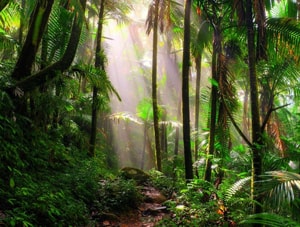Practice Reading & Listening on Rainforests
Practice Reading & Listening on Rainforests for IELTS
What are rainforests?
Shrouded in a blanket of clouds, they awaken, their canopies of green glitter in the sun. Their wildlife starts to slither.
Chirp, and growl and one of the planet’s richest ecosystems (comes to life).
Rainforests are the oldest living ecosystems on the planet. Some can trace their origins to over 70 million years ago, back to a time when dinosaurs still roamed the Earth. While the giant reptiles have disappeared, rainforests continue to thrive growing on every continent except Antarctica.
Two types of rainforests
Two types of rainforests are scattered across the globe. Temperate ant tropical. Temperate rainforests are mainly found in the mid-latitudes, often near cooler, coastal, mountainous regions. Tropical rainforests are primarily located in warmer climates between the tropical of Cancer and the Tropic of Capricorn. As their names imply, temperate and tropical rainforests are the wettest forests on earth, receiving up to about 33 feet of rain per year.
Precipitation in rainforests
This precipitation plays a critical role in creating an exceptionally lush and biologically diverse habitat.
While rainforests only make up about 6% of the Earth’s surface area, they are home to over half of the world’s plant and animal species. This biodiversity creates benefits that extend far beyond the rainforests boundaries. Rainforests plants produce an assortment of food items, in addition to ingredients useful in everyday products and medicines. In fact, an estimated 70% of the plants used in cancer treatments are only found in rainforests.
Rainforests and the environment
On an even larger scale, rainforests help to stabilize the planet’s climate. Its lush, green vegetation regulates global temperatures by absorbing massive amounts of radiation from the Sun. They also absorb vast amounts of carbon dioxide and convert them into oxygen, about 40% of the planet’s breathable air.
Deforestation
Over the past few centuries, rainforests have disappeared at an alarming rate. Factors such as economic inequalities, human development and demand for natural resources have fueled the deforestation of these rich ecosystems. At the current rate, rainforests, which have survived for over 70 million years, may completely disappear within the next century. But through educational campaigns, sustainable logging practices, and cooperation with local communities, deforestation may begin to slow down helping preserve rainforests for many generations to come.




Hello Dr.Hariri. I have a question on this reading:
What are sustainable logging practices?
Hi Armaghan,
Sustainable means environmentally friendly or ecologically green, and logging refers to the act of cutting down tress. So, altogether, sustainable logging practices means logical and balanced act of cutting down trees, which is the exact opposite of deforestation.
Shrouded in a blanket of clouds they awaken. Their canopies of green glitter in the sun. Their wildlife starts to slither.
Chirp, and growl and one of the planets richest ecosystems (comes to life).
Rainforests are the oldest living ecosystems on the planet. Some can trace their origins to over 70 million years ago. Back to a time when dinosaurs still roamed the Earth. While the giant reptiles have disappeared, rainforests continue to thrive growing on every continent except Antarctica.
Two types of rainforests are scattered across the globe. Temperate ant tropical. Temperate rainforests are mainly found in the mid-latitudes. Often near cooler, coastal, mountainous regions. Tropical rainforests are primarily located in warmer climates between the tropical of Cancer and the Tropic of Capricorn.
As their names imply, temperate and tropical rainforests are the wettest forests on earth, receiving up to about 33 feet of rain per year. This precipitation plays a critical role in creating an exceptionally lush and biologically diverse habitat.
While rainforests only make up about 6% of the Earth’s surface area, they are home to over half of the World’s plant and animal species. This biodiversity creates benefits that extend far beyond the rainforests boundaries.
Rainforests plants produce an assortment of food items. In addition to ingredient useful in every products and medicines. In fact, an estimated 70% of the plants used in cancer treatments are only found in rainforests. On an even larger scale, rainforests help to stabilize the planet’s climate. It is lush, green vegetation regulate global temperatures by absorbing massive amounts of radiation from the Sun. They also absorb vast amounts of carbon dioxide and convert them into oxygen, about 40% of the planet’s breathable air.
Over the past few centuries, rainforests have disappeared at an alarming rate. Factors such as economic inequalities, human development and demand for natural resources have fueled the deforestation of these rich ecosystems. At the current rate, rainforests, which have survived for over 70 million years may completely disappear within the next century. But through educational campaigns, sustainable logging practices, and cooperation with local communities, deforestation may begin to slow down helping preserve rainforests for many generations to come.
I forgot to thank you for your transcription. I’m so sorry.